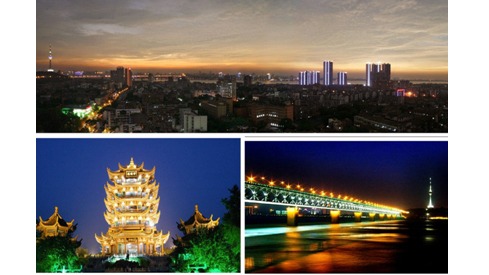Wuhan, or Han for short, is divided by Yangtse River, the third largest river in the world and Han River, its largest tributary, into three districts, namely Wuchang, Hankou and Hanyang. In the Tang dynasty, Li Bai, a famous poet, wrote "Fluting in the Yellow Crane Tower, you will see the falling May plum in Jiangcheng”. Wuhan was therefore known as Jiangcheng, or River City, in ancient China. It is also the world's most water-rich large city, the water area accounting for 1/4 of the city's land area, constituting Wuhan’s distinctive and magnificent eco-environment. Wuhan, the largest city in central China, is regarded as a core regional city, the first pilot city to introduce integrated transportation hub system, the third-ranked city regarding scientific education in China, a regional economic center and the financial, commercial, trade, logistics and cultural center in inland China. It is known as the world's "golden key" to open the Chinese inland market and an “overpass” of economic development. With a history of 3,500 years, Wuhan is one of the most time-honored large cities in China and the cradle of southern Chinese culture. Since the Spring and Autumn Period, Wuhan has been a key military and commercial city in southern China. In the late period of the Qing Dynasty, and the beginning of Republic of China and the People's Republic of China, Wuhan’s economy is among the most prosperous in Asia. In early Qing Dynasty when the "China-Russia Tea Road" opened up, Hankou, the starting point of this Road, gradually became the capital of tea trade in the world, known by the Europeans as "tea Harbour”. After Hankou was opened up to foreign countries, its foreign trade caught up with Shanghai, ranking the second in China, or the "Chicago of the East".
In 1911, the gunshot from Wuchang Uprising marked the onset of 1911 Revolution, which overthrew the imperialism and established the first republican country in Asia, leading to the foundation of the Republic of China. Between 1926 and 1949, the three districts were respectively called Hankou Special City (municipalities), Wuchang City (the capital of Hubei Province) and Hanyang County. In 1927, the National government moved its capital to Wuhan, incorporating Hankou, Wuchang, Hanyang together for the first time. On May 24, 1949, the Wuhan municipal government was established directly under the jurisdiction of the central government, which was the first municipality in New China. On June 19, 1954, the central government decided to change Wuhan into the capital of Hubei Province. Wuhan boasts three National Economic and Technological Development Zone, the production capacity of fiber optic cable ranking the first in the world and the comprehensive level of scientific education the third in China. It is China's largest inland water, land and air transportation hub, the comprehensive strength ranking the third in China only after Beijing and Shanghai. In 2007, the National Geographic, a magazine in the United States, listed Wuhan as one of the top ten metropolis in the world, becoming the first Chinese city on the list.
Since 2010, the Dongfeng Motor Corporation and Wuhan Iron and Steel Group have been ranked the world's top 500 enterprises for three consecutive years. In 2012, the total revenue of listed enterprises in Wuhan ranked 10th in Asia after Beijing, Tokyo, Seoul, Osaka, Mumbai, Shanghai, Taipei,Hong Kong, Kuala Lumpur.
Wuhan is now dedicated to building itself into a major city in China and a international metropolis under the goal of “Revitalizing the Great Wuhan”.
